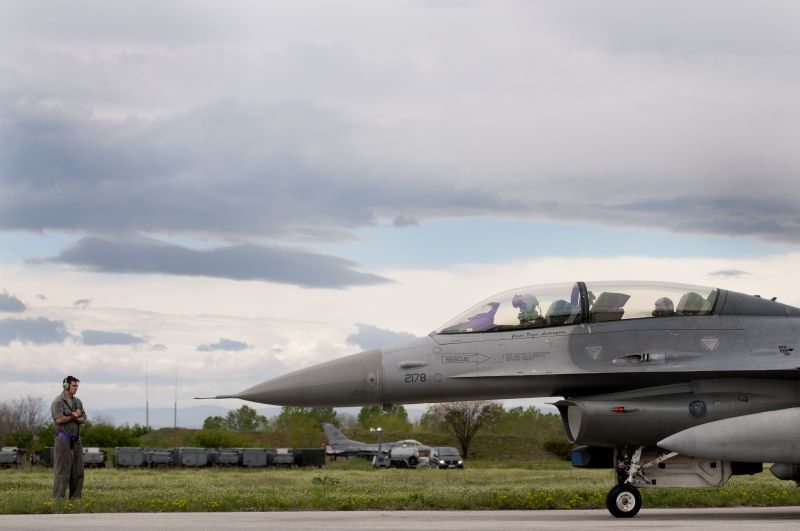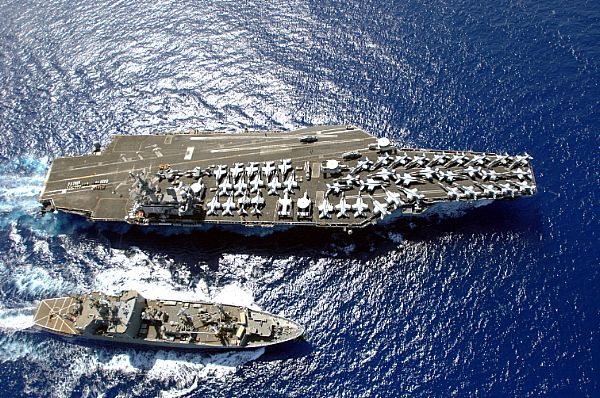More than 500 U.S. Airmen and two dozen F-16 Fighting Falcons from the 31st Fighter Wing here recently returned from a deployment to Graf Ignatievo Air Base, Bulgaria, where they spent a month conducting bi-lateral training with Bulgarian Airmen during Thracian Star 2012.
The exercise was the largest of its kind hosted at Graf Ignatievo since Bulgaria joined the NATO alliance in 2004 and included both Aviano fighter squadrons from Aviano Air Base, along with support personnel from several other 31st FW units. It was geared toward increasing interoperability and strengthening partnerships between the nations.
“As a NATO partner, we could be called upon to fight in a conflict together and knowing how each other trains and fights gives a little bit of insight into how would we integrate, and how would we be interoperable as a combined force,” said Lt. Col. Michael Thompson, 510th FS commander.
Gen. Mark A. Welsh III, U.S. Air Forces in Europe commander, visited Bulgaria during the exercise and agreed that the training was beneficial to both nations.
“It’s about building trust, it’s about learning from each other, and it’s about proving that we have the capability to deploy in an austere environment,” Welsh said. “It’s a fantastic opportunity for us.”
American and Bulgarian pilots flew together daily, completing 556 sorties over 16 flying days between April 17 and May 11, practicing close air support missions, basic fighter and air combat maneuvers, tactical intercepts, defensive counter air and large force missions with Bulgarian MiG-21 and MiG-29 pilots.
“The key phrase here is ‘increasing interoperability’ – that was one of the goals in this exercise, and we certainly accomplished that and more,” said Lt. Col. Karl Ingeman, 555th FS commander. “The joint training was invaluable for both our air forces and we both learned how to work together while accomplishing both the air to air and air to ground missions. The Bulgarian airspace and ranges were fantastic for training and it was a great experience that helped strengthen the alliance between our nations.”
The munitions, aircraft maintenance and maintenance operations squadrons worked jointly during the exercise, building and loading bombs and ammunition to be used for air-to-ground sorties, during which 536 bombs were dropped and 9,250 rounds of 20 millimeter ammunition were expelled at the local range.
With six or more hours of maintenance required per sortie, 31st Aircraft Maintenance Squadron personnel worked around the clock throughout Thracian Star to keep aircraft flying.
“We as a wing have never deployed both fighter squadrons and aircraft maintenance units to the same base with the number of people and aircraft we took in support of Thracian Star 2012,” Dubovik added. “This really tested and validated the wing’s ability to deploy in large numbers and operate together as one unit. Additionally, it was a tremendous opportunity for our Airmen to work alongside their Bulgarian counterparts, and to see both the similarities and differences between our two Air Forces. At the end of the day, we’re all Airmen and all maintainers sharing the same goals and challenges.”
Capt. Amanda McFeeters, 510th Aircraft Maintenance Unit officer in charge, agreed, also stating, “We normally operate in two separate locations. Combining maintenance operations for the Buzzards (510th FS) and the Nickel (555th FS) in about half the amount of space that we normally operate out of was one of the biggest challenges. I required everyone to be hyper vigilant and aware of their surroundings.”
The 31st Logistics Readiness Squadron was also a key component to the flying mission, with the petroleum, oils and lubricants flight pumping approximately 40,000 gallons of aircraft fuel per day.
Members of the 31st LRS were also responsible for packing, shipping, tracking and unloading all equipment and personnel, the magnitude of which required months of planning and preparation. Everything from aircraft parts and life support equipment to fire engines and fuel trucks was packed into 59 cargo trucks and four C-130s and added up to 710 tons of cargo shipped from Italy and Ramstein Air Base, Germany, to support the mission in Bulgaria.
With more than 500 personnel deployed from Aviano, nearly every unit from the 31st Fighter Wing was represented in Bulgaria, including members of the 603rd Air Control Squadron who provided essential communications support. The mobile communications unit arrived 10 days before the main body of deployed personnel and spent more than 400 hours setting up network connections, phone systems, radios and cell phones.
“It can appear a big task, but everyone has their own job so it all went pretty smoothly,” said Capt. Denise Shea, 603rd ACS mission systems flight commander. “When you first get there, it’s a matter of finding all your equipment and getting all set up. Then you get started and your training kicks in and it becomes second nature.”
Each and every Airman did their part, from aircraft maintainers and weapons loaders to logistics personnel and communications specialists, as noted by the USAFE commander during his visit.
“My USAFE Airmen rock, every day, everywhere, and they did the same thing here,” Welsh said. “They’re fantastic. They’re doing great work and they’re representing not just USAFE but our Air Force and our nation as well.”










